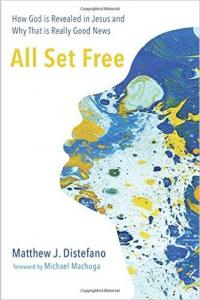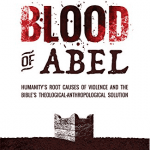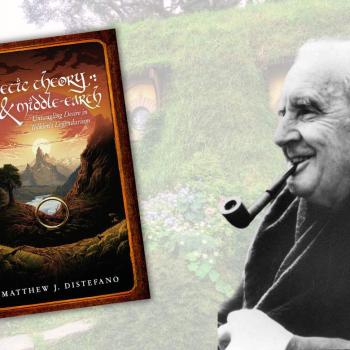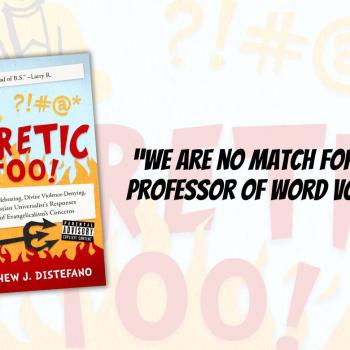 Introduction: From Fear to Freedom
Introduction: From Fear to Freedom
Fear is a terrible prison. Navigating the dark corridors of confusion and anxiety, searching for clarity and understanding and relief only to run into walls of self-doubt and torturous demons haunting your consciousness with the most terrifying “what ifs,” living in fear can be paralyzing, isolating, and self-diminishing. When the cause of such fear is anxiety about the nature or existence of God, it can be overwhelming, because the consequences it threatens are eternal. For one who struggles to believe in a God who is described by many to be both the very source of love and the author of the most excruciating eternal torments, admitting such fear is in itself a source of anxiety. In apprehension of isolating yourself by expressing worries no one else seems to acknowledge, in trepidation of essentially sealing a dreaded fate by admitting aloud that you just don’t know – when the horrors of hell for disbelieving somehow seem more palpable than the God whose blend of love and torture is impossible to comprehend – wrestling with such doubt, like Jacob in the Jabbok, can feel like drowning.
Although I come from a very different background within the Christian tradition than author Matthew Distefano, he has articulately expressed the fear that once held me captive – fear of my own unbelief, fear of hell, fear of God. But much more, he has succinctly and eloquently shone a light on his journey to the perfect Love that casts out such fear. The revelation of God’s universal healing and reconciling love in Jesus is undoubtedly a gift of grace, but Matthew has also put much effort into the metanoia – the transformation through the renewal of mind — that was begun in him by Christ. His assurance that God’s love enfolds everyone has come through careful study of theology, anthropology, hermeneutics, and the historical context of Jesus’s life and ministry. I saw parallels to my own journey while reading this book, and find that it both enhances my understanding of God’s love and helps me to communicate to others the amazing process of moving from anxiety to adoration and distress to discipleship. Should you be haunted by frightening interpretations of scripture or perplexed by the violence of God, reading this book with an open heart and mind (and an open Bible!) will not only illumine Matthew’s journey from fear to freedom, but may well propel you on a journey of your own! I know it is Matthew’s hope, and mine as well, that all will one day be All Set Free.
Is God Violent?
Though Matthew’s faith journey is different from mine, the fears that haunted us both, along, perhaps, with the desire in spite (or partly because) of those fears to know God better, led us both to the same question: “If there is a God, is he/she violent?” (xii) It is perhaps the most important question that can be asked, for how it is answered according to each person who asks (or subconsciously assumes) will have profound implications on that person’s understanding of the world and, thus, the mark that person leaves on the world. Belief in a violent God will lead to justification of violence, even if the goal of such violence is peace through the eradication or subduing of enemies. It is clear that a great deal of humanity is caught up in such an understanding of God. Yet the significance of this question encompasses but also transcends how it is answered by people. If the answer is “No, God is not violent at all,” then there is hope beyond the vicious cycle of violence that has entrapped so many, and hope for reconciliation for all within the all-encompassing mercy of God. The implications of this exceedingly good news are mind-blowing; to think, all the pain, suffering, heartache, devastation – physical and social and economic and psychological and spiritual violence – will all one day be made well by One who will wipe every tear from every eye!
Matthew’s continuing theological journey led him to a conclusive “No” to the question of God’s violence. The fullness of God’s peace that surpasses all human understanding is a continuing revelation, but the affirmation that “God is Love and in Him there is no darkness at all,” is assured. The beauty of this news has made Matthew want to shout God’s grace from the rooftops at any cost, and he writes with passion. However, coming out of fear, coming out of a well-meaning community that interpreted the violence of scripture at face value, Matthew shows deep empathy for those who believe in, or fear, eternal consequences for incorrect belief. The God portrayed in scripture is indeed frightening without a particular hermeneutical lens. That lens is Jesus, but Jesus can only be properly understood in the context not only of his human history, but in the context of what it means to be human at all. Thus, after a brief examination of the roots of Universalism within historic Christianity, giving the skeptical reader an initial hope that such all-encompassing love may not be “too good to be true” after all, Matthew leads the reader on a journey through anthropology as well as theology. Embarking on the path laid by Matthew’s scholarship, the reader travels beyond the walls of fear to the astonishing light of news that is better than many have ever dared to imagine.
Journey Through Science, Scripture, and Spirit
Matthew convincingly argues that if we do not know ourselves, we will project unconscious presuppositions onto whatever it is that we study or engage. This is particularly problematic when we seek to understand God, for we will inevitably recreate God in our own image, with devastating consequences! Thus it is necessary to approach scripture – the record of humanity’s relationship with God – from an anthropological perspective as well as a theological perspective. And for understanding what it means to be human, Matthew turns to René Girard.
Matthew’s treatment of Girard’s mimetic theory and its implications on human nature and the link between religion and violence at the foundation of human culture is succinct but sufficient to illumine the necessity of an anthropological lens upon scripture. Such a lens changes everything! Understanding how human beings are formed in relationship to one-another, how we are designed for imitation, gives profound insight into the inner workings of both love and violence, for both are products of human connection. Imitation of not only behavior, but of desires, can lead to connection when the object of those desires is shared, but conflict when the object of those desires is coveted exclusively for oneself.
In the section “The Girardian Trajectory,” Matthew efficiently shows how shared desires lead to conflict, how conflict escalates, and how the ensuing violence that threatens to consume and destroy the community finds an outlet in a scapegoat. Onto the scapegoat all the evil intention of the community to destroy one-another is projected, so that s/he is seen as the origin of the conflict; the original objects of shared desire are forgotten in the focused, righteous hatred against the scapegoat. Once expelled from the community, by collective murder or expulsion, the resulting catharsis brings such a euphoria that the scapegoat once considered evil is now the bringer of peace, supernatural, divine. However, because conflicts will inevitably arise again, it will be necessary to repeat such collective violence. Eventually, these patterns of violence and violent peacemaking will turn into conscious safeguards against all-out violence – rules, routines, and sacred stories to remember them by – that will form human culture. Matthew eloquently traces the initial murderous event that unifies the community through the pillars of culture – prohibition, ritual, and myth – to show how the violent resolution to conflict gave rise to religion.
Once one understands the link between violence and religion, once one sees religion as a violent safeguard against violence, the violence of scripture begins to make sense. The notion of a violent god is deeply ingrained in the origins of human civilization, and the demands for sacrifice in scripture are illuminated. Yet scripture tells another story as well, a story of humanity on its way out of the darkness of fearful subservience to a violent god, out of its entrapment in violent conflict with one another. There are signs of a God who brings peace and order not through violence, but through mercy, who resolves human conflict by rechanneling desires so that people live for the good of others rather than themselves. There are injunctions from the prophets to care for the poor and marginalized, those who had been scapegoated and ostracized by their communities in order to “keep the peace.” All of this culminates in, and is fully revealed by, the full embodiment of God in human form. Jesus, our model, our liberator from the cycle of violence, our Prince of Peace, shows us what it means to be fully-human, to live into our destiny as image-bearers of God.
Informed by mimetic theory, Matthew Distefano can take a discerning eye to scripture, separating the anthropological revelation – the human understanding of a warrior God who brings limited peace to limited people through sacrifice and conquest – from theological revelation, the breaking-in of God’s mercy to challenge sacrifice, bring the marginalized into the sphere of public concern, and halt cycles of violence with forgiving love. With Jesus as the ultimate model, imitating the Father and enjoining us to imitate him, scripture presents the alternative – the cure – to negative mimesis as positive mimesis. Matthew traces Jesus’s hermeneutic, his interpretive lens, on scripture through the New Testament references to the Hebrew Bible to show how Jesus rejected the violence of God. Instead, Jesus modeled the concern for the poor and marginalized that the prophets spoke about – concern that was a critique of human violence mistakenly attributed to or thought to be commanded by God. Ultimately, however, Jesus confronts the depths of human violence not only through his teachings, but through his death and resurrection. After illuminating the scapegoating mechanism, Matthew deftly explains how Jesus – God incarnate – undergoes that very mechanism, enduring all of humanity’s violent projections, all of the hate and fear and shame and blame – becoming the victim of humanity’s deadly curse of violence – in order to undo humanity’s violent mechanism for achieving peace. In the resurrection, Jesus’s innocence was vindicated, and all of the prohibitions, rituals, labels and walls that humans use to keep peace by casting others out were put on trial and exposed for the unholy violence that they are. Through his analysis of scripture informed by mimetic theory, Matthew Distefano convincingly argues that God has nothing to do with violence, that the violence in the atonement is ours, and we are “atoned” (at-one-d) by God’s gracious mercy in spite, not because, of violence. Yet if violence has always been humanity’s means of achieving peace, and violence is now exposed for the evil that it is and rendered impotent, what now will save us from imitating one-another’s desires and becoming entrapped in conflict, rivalry, and war?
Only Love can bring peace. That is the message of Jesus. Peace built on the backs of scapegoats, peace built over the graves of victims, will always fail, but Love will restore all things, just as love restored Jesus to life. Matthew Distefano convincingly argues that this Love must embrace all, for to sacrifice any one is to leave the scapegoat mechanism in tact. A God who saves us from sacrifice must save us all, must not sacrifice any one of us. Matthew makes it abundantly clear a God who answers violence with love will not inflict violence in an everlasting torment of hell. However, he explains the references to hell in scripture as the temporal consequences of human violence. He even explains how the mercy of God may involve pain – pain as of a wound being healed, as we are disciplined, corrected, purged of the violence so deeply ingrained in our identities which are ultimately foreign to the image of God in which we were created. He takes on some of the difficult sayings of Jesus and reads them, not in the light of a violent god whom we now know is a product of deficient human understanding, but in the light of mercy that can be experienced as severe. Being embraced in God’s mercy ultimately means becoming aware of the pain one has inflicted upon others, because God brings every victim, including our own, out of the shadows. Such mercy may indeed sting, but it is grace. Matthew articulates God’s severe but undeniably beautiful grace with passion, compassion, wisdom and humility.
Conclusion
But if you are a long time reader of Raven, none of this is new to you. You may not be trapped in an existential fear of hell (though there is much here to read if you are in doubt or anxiety!) Perhaps your greatest fear right now is in finding the perfect gift for your loved one. If that is the case, I encourage you to become All Set Free of your holiday stress and buy Matthew Distefano’s book today! (P.S. If this hard-sell, which is just an attempt at humor, bugs you, please pretend I ended this review with the penultimate paragraph above! Happy Holidays!)
~ Lindsey Paris-Lopez













